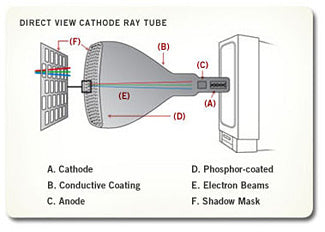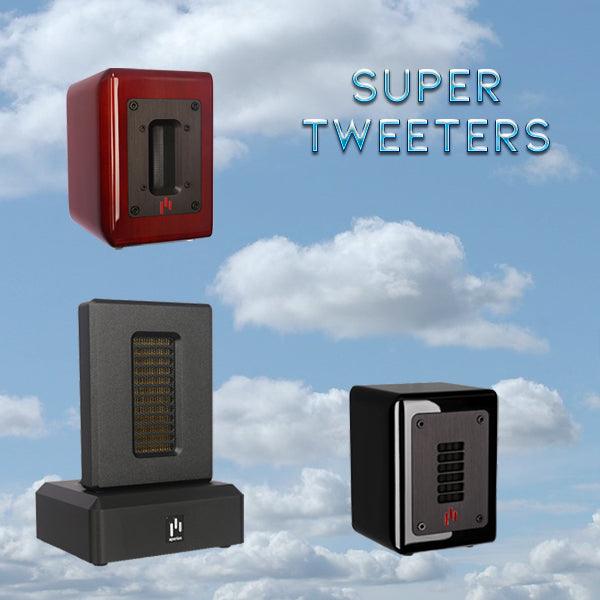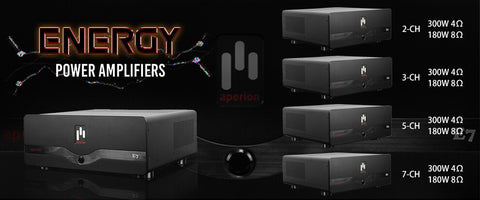Direct View—A True Original

Still the most common TV in homes today, Direct View CRT (Cathode Ray Tube) is the original granddaddy that started it all. Invented in the late 1920s, the concept remains essentially the same to this day. A glass vacuum tube with a flat screen is covered with red, blue and green phosphors. These phosphors light up whenever they’re hit by a scanning electron beam.

televisions receive an electronic signal that they then convert to beams of light. These beams are then projected as lines onto the backside of the TV screen where the phosphors react. Each beam begins at the top, moving from left to right, and from top to bottom. This all happens 30 times a second, faster than your eyes can detect, so your eyes see the result as a complete image.
A major improvement to CRT technology is interlaced scanning. Interlaced scanning refers to the beam’s ability to go back and fill in the lines it skips on the first pass. Of course, now the beam has to pull double duty to keep the image complete. It’s happy to do so as it scans a second pass 60 times a second, producing a visually richer image.
The bottom line: Direct View CRT may be older technology, even dated according to some enthusiasts, but refinements continue to be impressive. Picture quality is superlative.
- - - - - - - - - - - - - - - - - - - - - - - - - - - - - - - - - - - - - - - - - - - - - - - - - - - - - - - - - - - - - - - -
Some things to consider when looking at Direct View CRT:
The Pros
- Your least expensive option
- Bright, easy to see screens
The Cons
- Heavy and bulky due to the glass vacuum-tube
- Size limitations (the largest set is 40”)
- The screens reflect background light<
- - - - - - - - - - - - - - - - - - - - - - - - - - - - - - - - - - - - - - - - - - - - - - - - - - - - - - - - - - - - - - - -
Rear Projection Vs. Front Projection
1. Rear Projection
Available in sizes from 40” to 80”, recent advancements in rear projection TVs have begun to replace the three-color projector bulbs with a DLP (Digital Light Projector) LCD rear projection or LCOS or XSRD (Sony). The DLP is an ingenious projector that uses a single, high-intensity bulb that shines through a color filter wheel onto a chip, and then reflects the image onto the screen. Rear Projection TVs cost a bit more but what your pocketbook gives up your picture gains in sharpness and splendor.
The Pros
- Very large screen sizes are available
- The color is more accurate and true-to-life
The Cons
- Not as bright as Direct View or Plasma screens
- Bulbs last around 6000hrs and are expensive to replace
- Viewing from an angle diminishes image quality
2. Front Projection
Front projection TV systems are composed of a projector and a screen, similar to the setup at your local movie theater. The image created by front projection TVs generally starts at 60” to 80” and can get impressively large—up to 250”. The only factors that might limit screen size are your room dimensions, your room’s darkness level and that upright piano no one uses.
- - - - - - - - - - - - - - - - - - - - - - - - - - - - - - - - - - - - - - - - - - - - - - - - - - - - - - - - - - - - - - - -
THERE ARE THREE TYPES OF FRONT PROJECTION TVs:
A. CRT (Cathode Ray Tube)
Common in sports bars and conventions, these are the larger models with three-color tubes. The image quality is fantastic, assuming, of course, one is up for the cost and maintenance to own one.
B. LCD (Liquid Crystal Display)
With an LCD projector, a single light is directed through a lens toward the screen. This is a much smaller unit and is virtually a staple in corporate conference rooms.
C. DLP (Digital Light Projector)
As mentioned before, a digital light projector uses microscopic mirrors and a color wheel filter to produce an enhanced image. This technology is available in both front and rear projectors.
When looking at Front Projectors consider:
The Pros
- Provides the largest screen sizes available
- Image quality is superb and most resembles a movie theater
The Cons
- Initial cost and maintenance (alignment and burned bulbs) can be steep
- Your room needs to be darker with the ability to control light
- Installation can be a bear
- - - - - - - - - - - - - - - - - - - - - - - - - - - - - - - - - - - - - - - - - - - - - - - - - - - - - - - - - - - - - - - -
Direct View LCD—Think Computer Monitor But Better
Extra video inputs plus a flat-panel computer monitor equals the stunning LCD (Liquid Crystal Display). These babies are getting more and more popular with screen sizes ranging from 6” to 37”. LCD TVs use the same technology as laptop computer screens. The mental note for you to make is that, much like computer screens, quality between models can vary widely. Look closely, ask questions and do your research.
A bit on the pricey side, LCD TVs are worth looking at. Bear in mind:

The Pros
- Extremely compact enclosures (can be mounted on a wall)
- Excellent image quality depending on model
- Can double as a monitor for a computer system
The Cons
- Larger models can be very expensive
- Viewing at an angle may diminish quality
- Black levels are not a good as Plasma, RPJ, or CRT
- - - - - - - - - - - - - - - - - - - - - - - - - - - - - - - - - - - - - - - - - - - - - - - - - - - - - - - - - - - - - - - -
The Big, Flat Plasma
Similar to LCD TVs, Plasma units have a very shallow screen depth (3” to 6” average). Unlike LCDs, Plasma TVs use tiny red, green & blue gas-contained cells. These cells are ignited by electrical charges to produce a sharp, sumptuous picture. Because Plasma technology works best with larger screens, sizes range from 37” to 103”. Remember: because the technology is relatively young, advancements in features as well as shrinkage in price are both bound to happen. Be sure to scrutinize various models carefully as some are clearly superior to others.

The Pros
- Can be mounted on your wall
- Excellent image quality depending on the model
- Can be viewed in nearly any light condition and from various angles
The Cons
- Price, usually more expensive for the size.
- Repairs can be extremely expensive<









 https://www.aperionaudio.com
https://www.aperionaudio.com